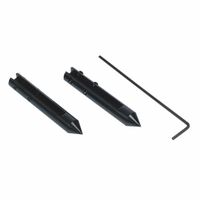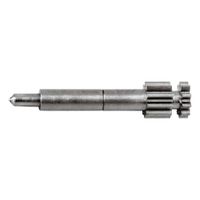Call +(254) 703 030 000 / 751 483 999 / 721 704 777
- Home
- Machining
- Precision Measuring Tools
- Calipers Accessories
- Parts Accessories For Calipers
.....Read More
Frequently Asked Questions
What are the most common caliper accessories?
The most common caliper accessories include:
1. **Depth Measuring Attachments**: These are used to extend the capability of calipers to measure the depth of holes or recesses accurately.
2. **Fine Adjustment Screws**: These allow for precise control over the movement of the caliper jaws, enabling more accurate measurements.
3. **Data Output Cables**: For digital calipers, these cables connect the caliper to a computer or data collection system, facilitating the transfer of measurement data for analysis or record-keeping.
4. **Protective Cases**: These are designed to store and protect calipers from damage, dust, and environmental factors when not in use.
5. **Calibration Standards**: These are precision tools or blocks used to calibrate calipers, ensuring their accuracy and reliability over time.
6. **Replacement Batteries**: For digital calipers, having spare batteries ensures that the caliper remains operational without interruption.
7. **Jaw Extensions**: These are used to increase the measuring range of calipers, allowing them to measure larger objects.
8. **Specialized Jaws**: These include pointed, knife-edge, or rounded jaws for measuring specific types of surfaces or features.
9. **Magnetic Holders**: These accessories help in holding the caliper in place, especially useful in repetitive measurement tasks.
10. **Conversion Charts**: These are often included with calipers to assist in converting measurements between different units, such as inches to millimeters.
11. **Cleaning Kits**: These kits include tools and solutions for maintaining the cleanliness and functionality of calipers.
12. **Locking Screws**: These are used to lock the caliper jaws in place, ensuring consistent measurements during repetitive tasks.
How do I choose the right caliper jaw points?
To choose the right caliper jaw points, consider the following factors:
1. **Measurement Type**: Determine whether you are measuring external, internal, depth, or step dimensions. This will guide you to select the appropriate jaw type.
2. **Material and Surface**: Consider the material and surface finish of the object. For delicate or soft materials, use jaws with a protective coating or softer material to prevent damage.
3. **Size and Shape**: Match the jaw size and shape to the object's dimensions and geometry. For irregular shapes, flexible or adjustable jaws may be necessary.
4. **Precision and Accuracy**: Ensure the caliper's resolution and accuracy meet the required measurement precision. High-precision tasks may require specialized jaws.
5. **Environment**: Consider the working environment. For corrosive or wet conditions, choose jaws made from stainless steel or other resistant materials.
6. **Ease of Use**: Select jaws that are easy to handle and adjust, especially for frequent or repetitive measurements.
7. **Compatibility**: Ensure the jaws are compatible with your caliper model and any additional measurement tools you may use.
8. **Cost and Durability**: Balance cost with durability. High-quality jaws may have a higher upfront cost but offer better longevity and reliability.
9. **Brand and Manufacturer**: Consider reputable brands known for quality and precision in measurement tools.
10. **User Feedback and Reviews**: Research user reviews and feedback for insights into performance and reliability.
By evaluating these factors, you can select the right caliper jaw points for accurate and efficient measurements tailored to your specific needs.
What is the purpose of caliper styli and extensions?
Caliper styli and extensions are essential components in precision measurement tools, particularly in coordinate measuring machines (CMMs) and calipers, used in various industries for quality control and assurance. Their primary purpose is to enhance the versatility, accuracy, and reach of measurement instruments.
Caliper styli are the contact points that physically touch the object being measured. They come in various shapes and materials, such as ruby, ceramic, or tungsten carbide, to suit different measurement needs and surface types. The purpose of caliper styli is to ensure precise contact with the workpiece, minimizing measurement errors due to surface irregularities or material properties. They are designed to provide accurate data by maintaining consistent contact pressure and reducing wear over time.
Extensions, on the other hand, are used to increase the reach of the measuring instrument. They allow the measurement of features that are otherwise inaccessible due to the size or geometry of the workpiece. Extensions are crucial for measuring deep or recessed features, internal dimensions, or large components where direct access is limited. By using extensions, operators can maintain the accuracy and reliability of measurements without compromising the structural integrity of the measuring tool.
Together, caliper styli and extensions enhance the functionality of measurement instruments, allowing for comprehensive inspection of complex parts. They enable precise measurement of intricate geometries, ensuring that components meet specified tolerances and quality standards. This is vital in industries such as aerospace, automotive, and manufacturing, where precision and accuracy are critical for safety, performance, and compliance.
How do I maintain and replace caliper battery covers?
To maintain and replace caliper battery covers, follow these steps:
1. **Identify the Battery Cover**: Locate the battery compartment on your caliper, usually found on the back or side of the device.
2. **Gather Tools**: You may need a small screwdriver, typically a Phillips or flathead, depending on the caliper model.
3. **Remove the Old Cover**:
- If the cover is secured with screws, carefully unscrew them and set them aside.
- If it’s a snap-on cover, gently pry it open using your fingers or a flathead screwdriver.
4. **Inspect the Battery Compartment**: Check for any corrosion or dirt. Clean the compartment with a dry cloth or a cotton swab dipped in isopropyl alcohol if necessary.
5. **Replace the Battery**: If needed, replace the old battery with a new one, ensuring it is the correct type and orientation as indicated in the compartment.
6. **Install the New Cover**:
- Align the new cover with the compartment.
- If it’s a snap-on type, press it firmly until it clicks into place.
- If it’s secured with screws, align the holes and carefully screw them back in without over-tightening.
7. **Test the Caliper**: Turn on the caliper to ensure it functions correctly with the new battery and cover.
8. **Regular Maintenance**: Periodically check the battery cover for any signs of wear or damage. Clean the caliper regularly to prevent dust and debris from affecting the battery compartment.
By following these steps, you can effectively maintain and replace caliper battery covers, ensuring the longevity and accuracy of your measuring tool.
What are compact calipers used for?
Compact calipers are precision measuring tools used to determine the dimensions of an object with high accuracy. They are commonly used in various fields such as engineering, metalworking, woodworking, and manufacturing. The primary function of compact calipers is to measure the internal and external dimensions, as well as the depth of an object.
These calipers are designed to be portable and easy to handle, making them ideal for use in tight spaces or on-site measurements where larger tools would be cumbersome. They typically feature a sliding scale with a fixed jaw and a movable jaw, which can be adjusted to fit the object being measured. The measurement is read from a scale, which can be either digital or analog (vernier).
In engineering and manufacturing, compact calipers are essential for quality control and ensuring that parts meet specified tolerances. They are used to measure the diameter of holes, the thickness of materials, and the distance between two points. In woodworking, they help in achieving precise cuts and fits, ensuring that pieces join together seamlessly.
Compact calipers can also be used in scientific research and laboratories for measuring specimens or components with precision. They are available in various materials, including stainless steel and carbon fiber, to suit different applications and environments.
Overall, compact calipers are versatile tools that provide accurate measurements, contributing to the precision and quality of work in various industries.
How do depth stops improve caliper measurements?
Depth stops improve caliper measurements by providing a consistent and repeatable reference point for measuring depth. They ensure that the caliper is positioned correctly and uniformly each time a measurement is taken, reducing the likelihood of human error. This consistency is crucial for achieving accurate and reliable measurements, especially in precision engineering and manufacturing where even minor discrepancies can lead to significant issues.
By using a depth stop, the user can set a predetermined stopping point for the caliper's measuring jaws or depth rod. This allows for quick and efficient measurements without the need to manually align the caliper each time, thus speeding up the measurement process and increasing productivity. Additionally, depth stops help in maintaining the perpendicularity of the caliper to the surface being measured, which is essential for obtaining true depth readings.
Furthermore, depth stops can be adjusted to accommodate different measurement requirements, providing versatility and adaptability in various applications. They also help in reducing wear and tear on the caliper by minimizing unnecessary movement and handling, thereby extending the tool's lifespan.
Overall, depth stops enhance the precision, efficiency, and durability of caliper measurements, making them an invaluable feature for professionals who require accurate depth measurements in their work.
Where can I find replacement parts for calipers?
You can find replacement parts for calipers at the following places:
1. **Auto Parts Stores**: Major chains like AutoZone, O'Reilly Auto Parts, and Advance Auto Parts carry a wide range of caliper parts, including pistons, seals, and hardware kits.
2. **Online Retailers**: Websites like Amazon, eBay, and RockAuto offer a vast selection of caliper replacement parts. They often provide customer reviews and competitive pricing.
3. **Manufacturer's Website**: If you know the brand of your calipers, check the manufacturer's website for direct purchase options or authorized dealer listings.
4. **Specialty Brake Shops**: These shops focus on brake systems and may have a more extensive selection of caliper parts, including performance upgrades.
5. **Local Mechanics or Garages**: Some local mechanics may have spare parts or can order them for you, often providing installation services as well.
6. **Salvage Yards**: For older or rare vehicles, salvage yards can be a good source for used caliper parts at a lower cost.
7. **Performance and Racing Shops**: If you need high-performance caliper parts, specialized racing shops may have what you need.
8. **Forums and Online Communities**: Car enthusiast forums and online communities can be a resource for finding parts, as members often share where they source their components.
9. **Catalogs**: Some companies offer mail-order catalogs where you can find and order caliper parts.
10. **Local Dealerships**: For OEM parts, visiting a dealership that sells your vehicle's brand can ensure compatibility and quality.
Always ensure compatibility with your vehicle's make and model when purchasing replacement parts.


